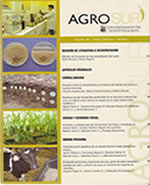Impact of mining contamination source on copper phytotoxicity in agricultural soils from central Chile
Main Article Content
Abstract
Chile is the largest producer of copper in the world. Mining operations have led to the contamination of neighboring agricultural soils through the deposition of smelter dust or spilling of mine tailings. However, the impacts of mining contamination source on copper phytotoxicity in soils are poorly resolved. Here we show that perennial ryegrass (Lolium perenne L.) exhibits different phytotoxicity responses when grown in agricultural topsoils contaminated by smelter dust than in those contaminated by tailing sand. Specifically, shoot length of ryegrass decreased as a function of total soil copper concentration in soils contaminated with smelter dust. In contrast, no correlation was observed between shoot length of ryegrass and total copper concentration in soils contaminated with tailing sand. A potential explanation for the differential trends in copper phytotoxicity may be attributed to zinc. The tailing sand-contaminated soils had significantly higher total zinc concentrations than did the smelter-impacted soils (201 mg kg-1 versus 126 mg kg-1; p < 0.05). Shoot length significantly increased with increasing foliar zinc concentrations for ryegrass grown in tailing sand-contaminated soils (n = 23, R2 = 0.76, p < 0.001), whereas no significant correlation between shoot length and foliar zinc was observed for ryegrass grown in smelter-impacted soils. Thus, zinc seems to alleviate copper phytotoxicity in tailing sand-contaminated soils but not in smelter-impacted soils, which show clear copper phytotoxicity.

